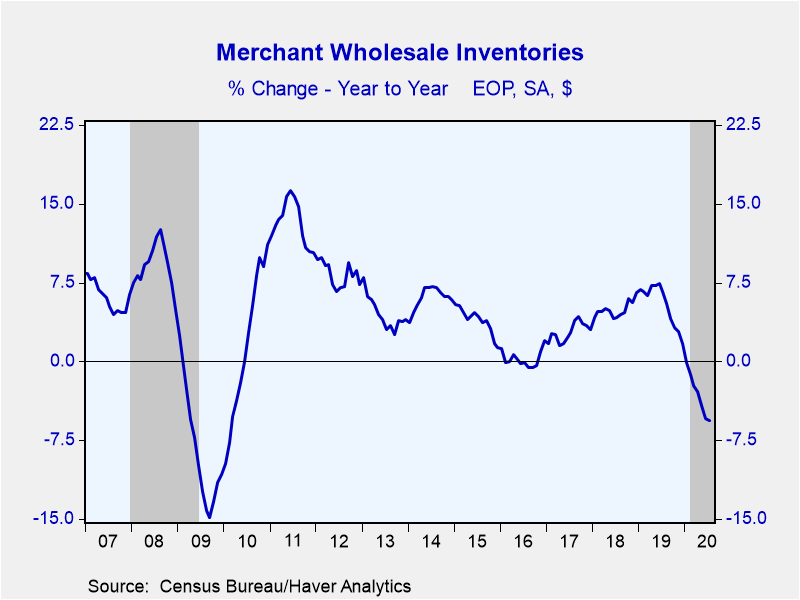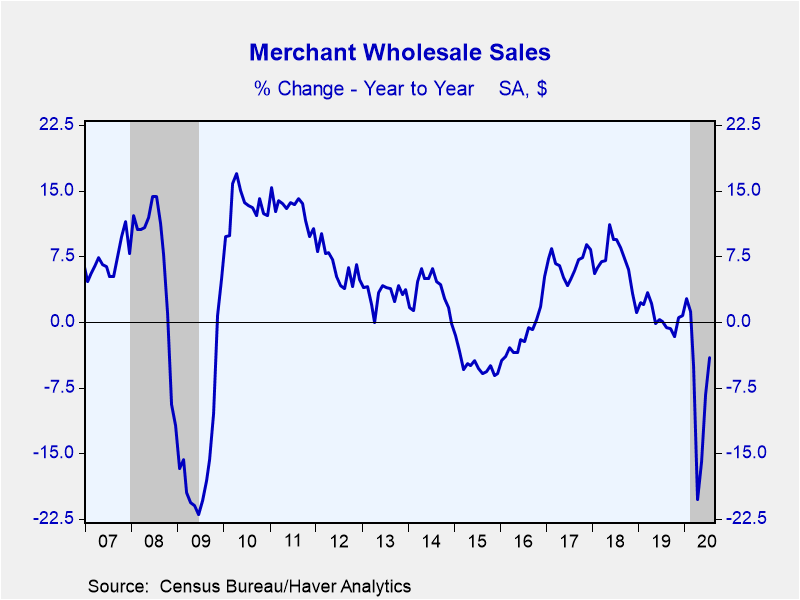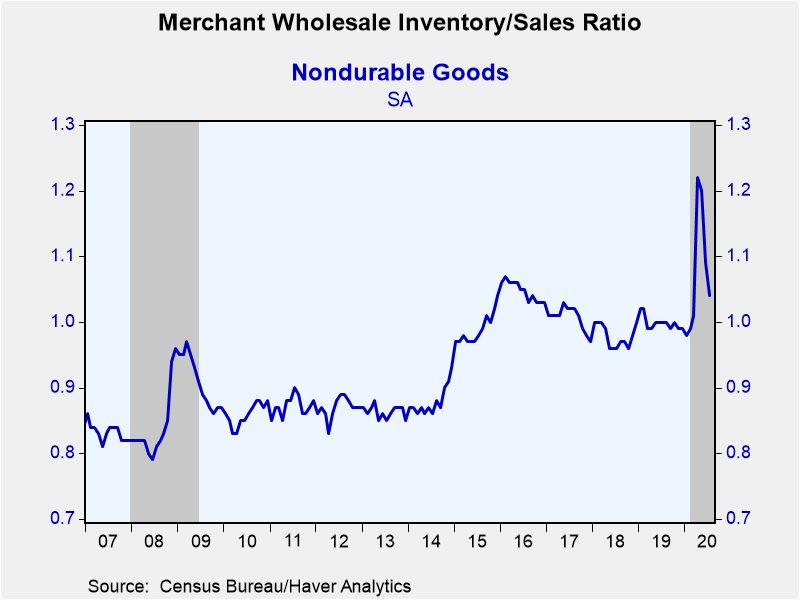 Global| Sep 10 2020
Global| Sep 10 2020U.S. Wholesale Inventories Ease While Sales Continue to Recover in July
by:Tom Moeller
|in:Economy in Brief
Summary
• Wholesale inventories drop for third straight month. • Sales continue to surge. • Inventory-to-sales ratio falls with sales' strength. Wholesale inventories worked lower again, falling 0.3% during July (-5.6% y/y) and continuing [...]
• Wholesale inventories drop for third straight month.
• Sales continue to surge.
• Inventory-to-sales ratio falls with sales' strength.
Wholesale inventories worked lower again, falling 0.3% during July (-5.6% y/y) and continuing this year's pattern of decline. The Informa Global Markets Survey anticipated a 0.1% slip. Durable goods inventories fell 0.9% (-7.5% y/y) as furniture & home furnishing inventories dropped 3.0% (-16.3% y/y). Motor vehicle & parts inventories fell 0.6% (-12.9% y/y) but electrical product inventories rose 1.0% (-3.3% y/y). Nondurable goods inventories rose 0.6% (-2.6% y/y). Grocery inventories increased 0.5% (3.5% y/y) while the value of petroleum inventories jumped 2.9% (-17.1% y/y) with higher prices. Apparel inventories weakened 4.7% (-7.5% y/y) following a 6.1% drop.
Wholesale sales grew 4.6% during July (-4.0% y/y) following two months of recovery from the recession. The Action Economics Forecast Survey anticipated a 2.8% rise. Durable goods sales increased 4.2% (-1.1% y/y) as auto sales jumped 9.4% (-3.0% y/y) and furniture & home furnishings sales rose 8.5% (-9.0% y/y). Nondurable wholesale sales gained 5.0% (-6.7%) as purchases of petroleum products surged 17.3% (-30.4% y/y). Apparel sales rose 8.5% (-19.5% y/y) and chemical sales gained 2.6% (-9.5% y/y).
The inventory-to-sales (I/S) ratio at the wholesale level declined to 1.32 in July from 1.38 in June, and was below a record 1.63 in April (data goes back to 1980). The durable goods ratio fell to 1.61 and was below the high of 2.09 in April. It reflected widespread declines across industries. The nondurable ratio also fell sharply to 1.04 and reflected widespread industry declines.
The wholesale trade figures and oil prices are available in Haver's USECON database. The expectations figure for inventories is contained in the MMSAMER database. Expectations for sales are in the AS1REPNA database.
| Wholesale Sector - NAICS Classification (%) | Jul | Jun | May | Jul Y/Y | 2019 | 2018 | 2017 |
|---|---|---|---|---|---|---|---|
| Inventories | -0.3 | -1.3 | -1.2 | -5.6 | 1.7 | 6.5 | 3.0 |
| Sales | 4.6 | 9.0 | 5.7 | -4.0 | 0.6 | 6.8 | 6.7 |
| I/S Ratio | 1.32 | 1.38 | 1.53 | 1.34 (Jul '19) | 1.34 | 1.28 | 1.30 |
Tom Moeller
AuthorMore in Author Profile »Prior to joining Haver Analytics in 2000, Mr. Moeller worked as the Economist at Chancellor Capital Management from 1985 to 1999. There, he developed comprehensive economic forecasts and interpreted economic data for equity and fixed income portfolio managers. Also at Chancellor, Mr. Moeller worked as an equity analyst and was responsible for researching and rating companies in the economically sensitive automobile and housing industries for investment in Chancellor’s equity portfolio. Prior to joining Chancellor, Mr. Moeller was an Economist at Citibank from 1979 to 1984. He also analyzed pricing behavior in the metals industry for the Council on Wage and Price Stability in Washington, D.C. In 1999, Mr. Moeller received the award for most accurate forecast from the Forecasters' Club of New York. From 1990 to 1992 he was President of the New York Association for Business Economists. Mr. Moeller earned an M.B.A. in Finance from Fordham University, where he graduated in 1987. He holds a Bachelor of Arts in Economics from George Washington University.










